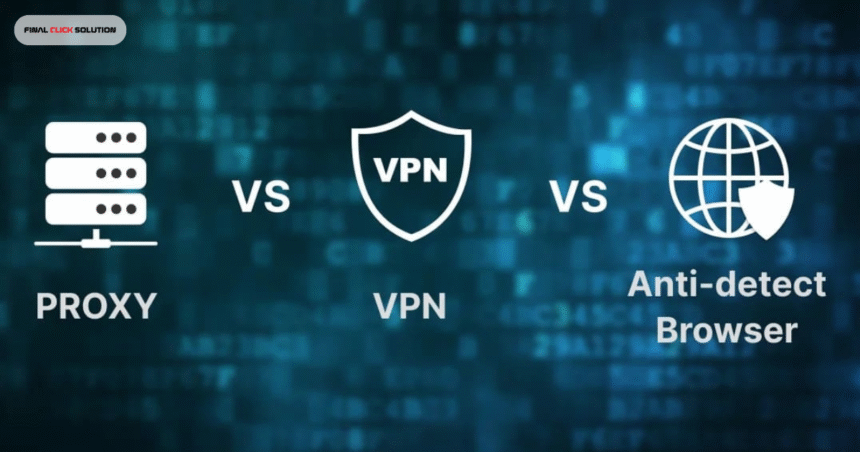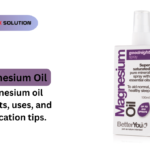Ever feel like no matter what you do online, use a VPN, clear cookies, switch incognito tabs, websites still seem to know who you are? That creepy “we see you” vibe isn’t just paranoia. It’s browser fingerprinting. Enter the world of antidetect VPNs.
Now, let me warn you: you won’t find a magical “antidetect VPN” packaged in a neat little box. What we’re talking about is a combo, a VPN plus a browser designed to outsmart even the nosiest trackers.
Let’s delve into its meaning, identify its usefulness, and explore how you can create a setup that truly transforms your online experience into stealth mode.
What Is an “Antidetect VPN”?
Let’s be honest: the term “antidetect VPN” is a bit misleading. A VPN hides your IP and encrypts your traffic. That’s great, but it’s not enough.
Websites don’t just look at your IP address. They examine your screen resolution, fonts, time zone, GPU, and even the way your browser renders shapes on a canvas. This digital fingerprint can be just as unique as a real one.
That’s where an antidetect browser comes in.
So when people say “antidetect VPN,” what they mean is this:
A VPN to hide your network identity + an antidetect browser to disguise your device fingerprint.
It’s a tag team. And together, they give you far more control over your online identity than either one can offer alone.
VPN vs Antidetect Browser: What’s the Difference?
I learned this the hard way. I was running multiple ad accounts for clients, rotating VPN locations, and patting myself on the back for being “safe.”
But somehow. Accounts still got flagged. Turns out, I was showing up with the same browser fingerprint every time, just from different IP addresses. That inconsistency? A red flag for fraud detection systems.
Here’s how they actually differ:
VPN (Alone):
- Masks your IP address
- Encrypts your internet traffic
- Doesn’t change your device/browser fingerprint
- Suitable for general privacy, but not for managing multiple identities
Antidetect Browser:
- Spoofs your fingerprint (screen size, GPU, OS, fonts, etc.)
- Let’s you create isolated browser profiles.
- Often lets you integrate proxies or VPNs per profile.
- Great for managing multiple accounts or personas
The Real Power: Using Both Together
- The VPN hides where you are
- The browser hides who you appear to be
Together, they create a much more believable and secure digital identity.
Top Antidetect Browsers in 2025
If you’re just starting out, here’s a quick tour of some tools people are loving this year. I’ve personally tried a few, some feel like overkill, while others are surprisingly easy.
- GoLogin
If you’re just getting started, GoLogin is an excellent choice. The interface is clean, it doesn’t overwhelm you with too many settings, and there’s even a free plan to mess around with. I found it great for small projects when I was first learning about this stuff.
- Multilogin
This one’s like the Rolls-Royce of antidetect browsers. It’s powerful, packed with features, and built for people running serious operations. I used it during a client-intensive phase, and while it’s not cheap, it never let me down.
- Kameleo
Kameleo is a solid choice if you’re a bit more technical, or if you’re into automation. It also supports mobile fingerprinting, which is a significant advantage for individuals conducting mobile-based testing or marketing. I’ve seen dev teams use this to run some impressive setups.
- DICloak
DICloak feels like that reliable budget tool that doesn’t try to do everything, but nails the basics. If you’re working solo or just need something lightweight to manage a few accounts, this one’s easy to recommend. Simple, effective, no fluff.
- Dolphin{Anty}
Honestly, I was surprised by how much Dolphin{Anty} offers for free. It’s perfect for small-scale use, and the fact that it allows up to 10 profiles without charging a dime is quite impressive. I’d call it the best “starter kit” out there.
- AdsPower
This one’s built with teams in mind. If you’re working with others or managing dozens of accounts across platforms, AdsPower has the bulk tools and collaboration features you’ll want. It requires a bit more setup, but once you get into the groove, it scales remarkably well.
How I Built My Setup (And What I Learned)
A while back, I was managing multiple e-commerce storefronts and ad campaigns. Each needed a different Facebook business account, ad account, and payment method. One VPN and a few Chrome profiles weren’t cutting it anymore. I kept running into roadblocks, verifications, and eventually bans.
So, I switched gears:
- Picked a stable VPN with a no-logs policy.
- Started using GoLogin for its friendly learning curve.
- Created individual browser profiles for each storefront.
- Added residential proxies to simulate different cities.
- Ran all of it through the VPN, so even proxy connections were encrypted.
Within a week, account flags dropped to nearly zero. Facebook stopped asking for endless ID verifications. It wasn’t just the tools, it was how I used them.
Who Needs an Antidetect VPN Setup?
You probably don’t need this level of anonymity to watch Netflix or check your email. But if you’re doing any of the following, it’s a game-changer:
- Running multi-account ad campaigns (Facebook, TikTok, Google)
- Managing freelance client accounts in different regions.
- Testing websites or platforms from different locations
- Performing affiliate marketing or dropshipping
- Creating social media personas or building online communities
- Conducting market research or scraping competitive data (legally, of course)
Let’s be clear: these tools are legit, when used ethically. Businesses, researchers, and marketers rely on them every day. What’s not okay? Using them for fraud, evasion, or anything shady. Don’t go there.
A Step-by-Step Setup (Made Simple)
Here’s the blueprint I wish someone had given me:
- Get a VPN: Opt for one that offers stable connections, no logging, and comprehensive coverage of locations.
- Download an antidetect browser: GoLogin or DICloak are great places to start.
- Set up your profiles: One profile = one identity. Keep everything separated, cookies, logins, even bookmarks.
- Integrate proxies (optional): For even more precision, assign a unique proxy to each profile.
- Test your setup: Use browser fingerprint checkers to verify everything’s working as expected.
- Go live: Whether it’s managing accounts or browsing securely, you’re now in stealth mode.
It’s not hard once you get the hang of it, just a bit of trial, error, and tweaking.
Be Aware: It’s Not Foolproof
Let’s keep it real, no system is perfect. A few things to watch out for:
- Inconsistent fingerprints can raise red flags. Sloppy spoofing is worse than no spoofing.
- Tool trustworthiness matters. Some antidetect browsers are closed-source, and you’re putting a lot of trust in them.
- Platform detection is evolving. Facebook, Amazon, and Google are continually improving their methods for detecting unusual patterns.
- It can get expensive. Premium tools and proxies can rack up fast, plan your setup around your needs and budget.
Still, with clever use and good hygiene, you’ll be way ahead of the average user.
Conclusion
In a world where digital identity matters more than ever, combining a VPN with an antidetect browser isn’t just a geeky trick, it’s a practical tool for marketers, entrepreneurs, and privacy-conscious folks alike.
Is it overkill for casual browsing? Probably.
But if you’re running a business, managing multiple accounts, or want to avoid being digitally fingerprinted every time you blink. This setup gives you control in a way no single tool ever could.







